DADeR
DADeR (Dramaturgical Aid for Designing Robots) is a database aimed to present dramaturgical advice with regard to robot design.
The setup of this database builds on the core idea presented in the text “Dramaturgy for Devices” (2021) by Bleeker and Rozendaal who argue that a “dramaturgy of devices supports the development of the objecthood and smartness of smart objects, and how dramaturgical insights regarding mise-en-scene, performativity, presence and address offer conceptual tools to supportand further develop various aspects of ecological approaches to design” (p. 52).
The database consists of student papers that were written as part of the course Expanding Performance (MA Contemporary Theatre, Dance and Dramaturgy, Utrecht University). This course was designed as a ‘Robot Intensive’ in experimental collaboration with AI students in Socially Intelligent Robotics course at VU Amsterdam. In their papers, students analyze concepts from dramaturgy and explain how they can provide insights in robot design using case studies.
[collapsibles]
[collapse title = “Aesthetics”]
“Aesthetics: Robter Wilson’s Dramaturgy of Dreams in Designing Smart Objects” – by Daphne Patsourakou
Concepts: aesthetics, dramaturgy of dreams
Case study: Living Light by artist collective Beyond Earth
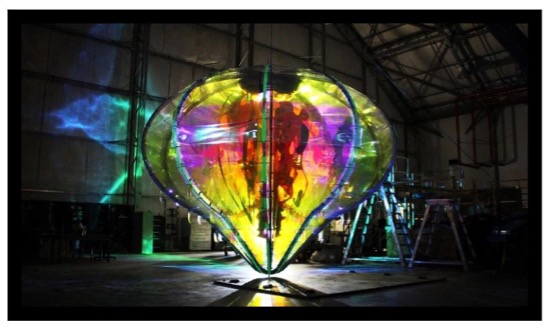 Conceptualizing the notion of “aesthetics” through Robert Wilson’s dramaturgy of dreams, this paper examines through this perspective the design case Living Light, which combines art, biology, AI, and aerospace technology. Taking under consideration the environment in which the smart object will be placed in and the mise-en-scène, the dramaturgy of dreams and its designing tools can provide a different lens, with which the aesthetic aspects of the smart object can be reimagined. This can be done by using a set of designing tools such as different “frames” and levels of tension of the light, various color pallets and combinations that create an anthesis with the environment, “weird” shapes, augmented sizes and different scales, absurd rhythm and repetition.
Conceptualizing the notion of “aesthetics” through Robert Wilson’s dramaturgy of dreams, this paper examines through this perspective the design case Living Light, which combines art, biology, AI, and aerospace technology. Taking under consideration the environment in which the smart object will be placed in and the mise-en-scène, the dramaturgy of dreams and its designing tools can provide a different lens, with which the aesthetic aspects of the smart object can be reimagined. This can be done by using a set of designing tools such as different “frames” and levels of tension of the light, various color pallets and combinations that create an anthesis with the environment, “weird” shapes, augmented sizes and different scales, absurd rhythm and repetition.
[/collapse]
[/collapsibles]
[collapsibles]
[collapse title = “Empathy”]
“Embodied Simulation: Speaking Up Through the Body” – by Sarah Goorhuis
Concept: embodied simulation (empathy, inner mimicry, mirror neurons)
Case Study: Nao robot
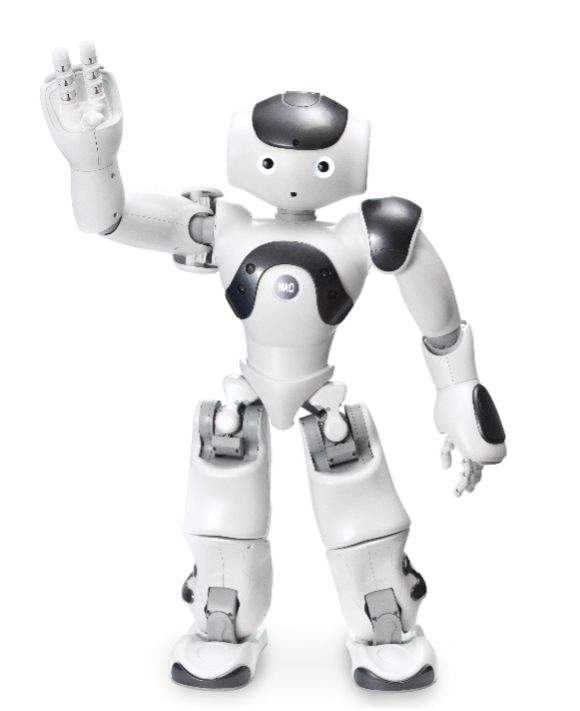 Embodied simulation can be utilized as an attainable tool for non-verbal communication between humanoid robots and humans. When we see a robot execute actions and movements, the same neural systems are activated as when we are watching humans move: seeing a robot move will activate an embodied simulation within the spectator. Although this is most apparent in observing humanoid robots, this can happen with the most abstract robot design, as long as there is something recognisable about an action or movement that we can relate ourselves to. Being conscious about the simulation that is irrevocably taking place when a human perceives a humanoid robot move can enable a stronger sense of empathy, which can help accomplish the design objective.
Embodied simulation can be utilized as an attainable tool for non-verbal communication between humanoid robots and humans. When we see a robot execute actions and movements, the same neural systems are activated as when we are watching humans move: seeing a robot move will activate an embodied simulation within the spectator. Although this is most apparent in observing humanoid robots, this can happen with the most abstract robot design, as long as there is something recognisable about an action or movement that we can relate ourselves to. Being conscious about the simulation that is irrevocably taking place when a human perceives a humanoid robot move can enable a stronger sense of empathy, which can help accomplish the design objective.
“Empathy in the Eye of the Beholder: Kinesthetic Empathy and the Suffering of the Robotic Performer” – by Jasmijn Ooms
Concept: (kinesthetic) empathy
Case Study: “Can’t Help Myself” by Sun Yuan and Peng yu
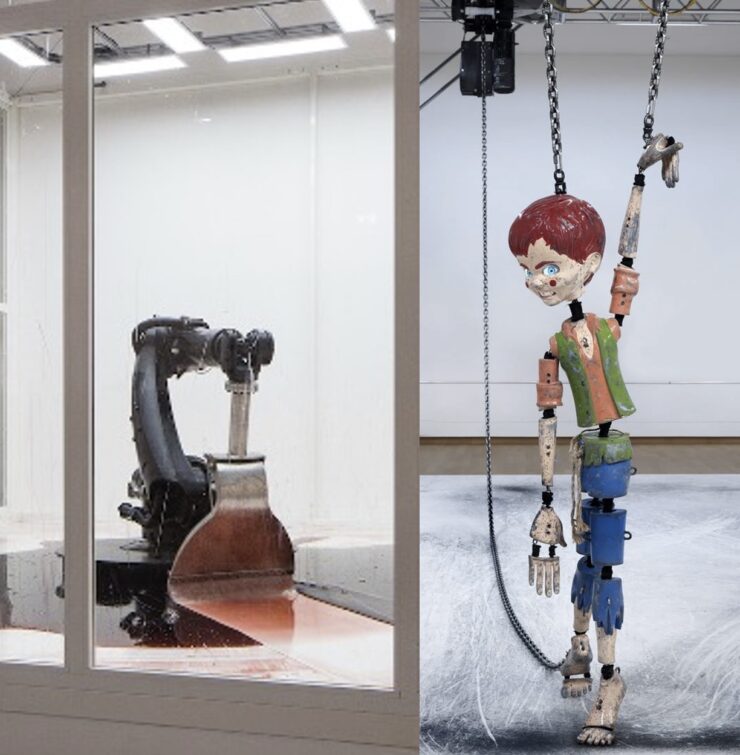 Kinesthetic empathy takes on a different meaning when its subject is a robotic performer. This paper considers the dramaturgical strategy that is necessary in order to create empathy inducing devices for performance arts, and how visually humanoid-looking devices may not be central to the audience resonance. Producing convincing dramaturgy of a device lies in its possibility of the performance being an exploration of the human psyche, reflecting the emotional response of the audience that looks upon it.
Kinesthetic empathy takes on a different meaning when its subject is a robotic performer. This paper considers the dramaturgical strategy that is necessary in order to create empathy inducing devices for performance arts, and how visually humanoid-looking devices may not be central to the audience resonance. Producing convincing dramaturgy of a device lies in its possibility of the performance being an exploration of the human psyche, reflecting the emotional response of the audience that looks upon it.
[/collapse]
[/collapsibles]
[collapsibles]
[collapse title = “Materiality”]
“Motive Intentions: Communication through Movement” – by Vivian de Koning
Concepts: materiality, address, kinaesthesia, intention
Case Studies: Roomba (iRobot), Spot (Boston Dynamics)
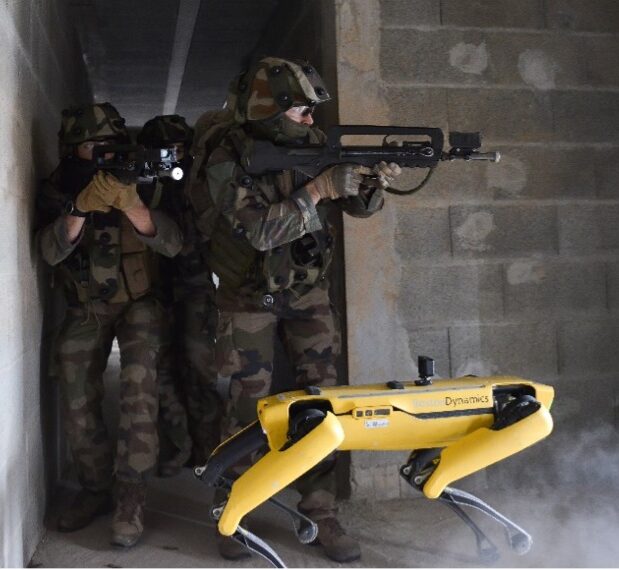 Movement cannot be imply meaning on its own; rather, it is the surrounding environment that gives meaning to it. Based on the concepts of “address” and “kinaesthesia”, this paper argues that robots move to make sense of their environment, in order to best traverse it, and learn in the traversing what their environment is. Due to the distinctly non-human looks of both the Roomba and Spot, these robots cannot move in a way that is human. They can, however, still move in ways that lead to affection or affinity for these objects. To express certain intentions through a robot, one must design its movements based on their materiality rather than blindly mimicking humans.
Movement cannot be imply meaning on its own; rather, it is the surrounding environment that gives meaning to it. Based on the concepts of “address” and “kinaesthesia”, this paper argues that robots move to make sense of their environment, in order to best traverse it, and learn in the traversing what their environment is. Due to the distinctly non-human looks of both the Roomba and Spot, these robots cannot move in a way that is human. They can, however, still move in ways that lead to affection or affinity for these objects. To express certain intentions through a robot, one must design its movements based on their materiality rather than blindly mimicking humans.
“Materiality, Improvisation, and Performativity in Robotic Musicianship” – by Melanie Stahlecker
Concepts: materiality, improvisation, performativity
Case Study: Shimon robot
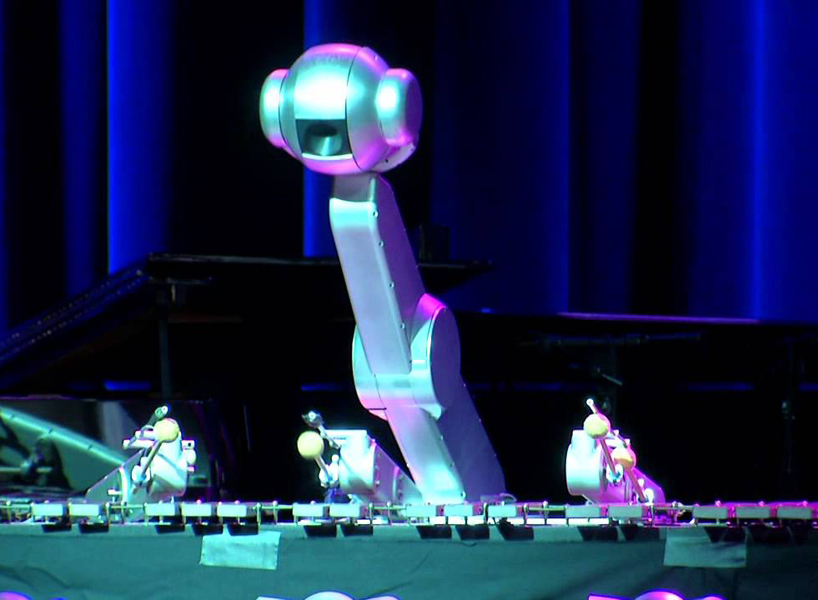 Through an examination of “Shimon” the marimba-playing robot, this paper specifies the importance of materiality, improvisation, and performativity in robot design and argues that designing the robot to be human-like can improve its musical performance as well as enhancing its collaboration with humans. Producing good music is a complex, creative process that requires much attention to details. This includes training the robot’s artificial intelligence, developing facial expressions and body language, and considering adequate materials for the instruments it plays.
Through an examination of “Shimon” the marimba-playing robot, this paper specifies the importance of materiality, improvisation, and performativity in robot design and argues that designing the robot to be human-like can improve its musical performance as well as enhancing its collaboration with humans. Producing good music is a complex, creative process that requires much attention to details. This includes training the robot’s artificial intelligence, developing facial expressions and body language, and considering adequate materials for the instruments it plays.
[/collapse]
[/collapsibles]
[collapsibles]
[collapse title = “Presence”]
“(Radical) Presence and Ecology” – by Eedi Karjalainen
Concepts: (radical) presence, ecology
Case Study: PetChatz
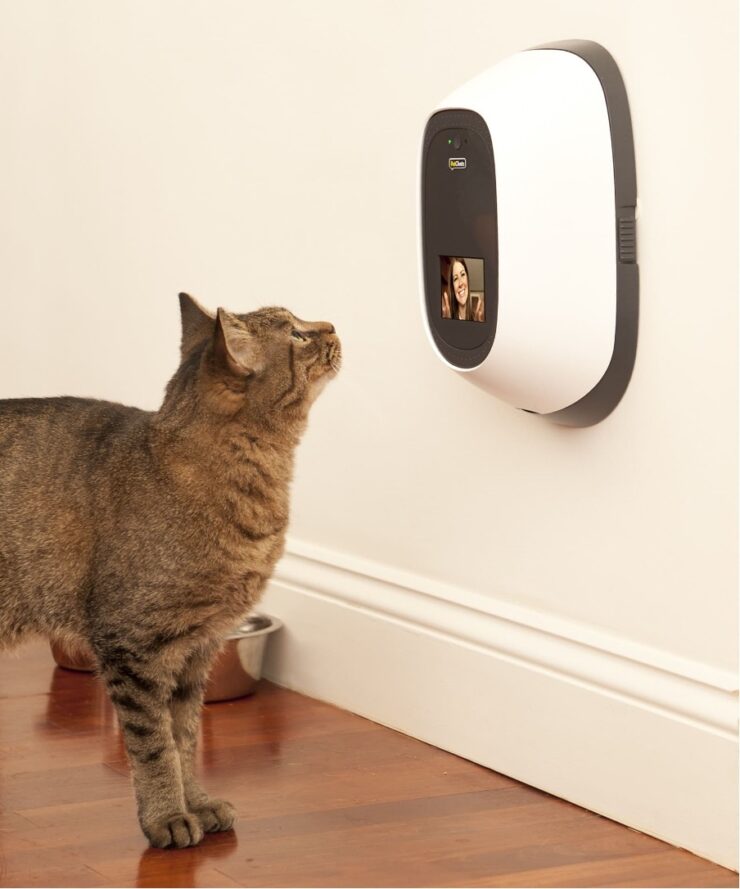 Taking an ecological approach to smart object design shows how to equalise pet-owner relations. Evaluating PetChatz as containing qualities of radical presence enables a re-thinking of the smart object as beyond mediatory. The object finds it strengths in the way it has addressed the environment in which it is situated in and by going beyond the mere role of a moderator, as evidenced through the framework of radical presence and ecology. Through these qualities, the smart object manages to encourage mutual agency of owner and pet. If the smart object has radical presence, then the smart object must have the same level of agency as the users it mediates to initiate, moderate and experience the interaction.
Taking an ecological approach to smart object design shows how to equalise pet-owner relations. Evaluating PetChatz as containing qualities of radical presence enables a re-thinking of the smart object as beyond mediatory. The object finds it strengths in the way it has addressed the environment in which it is situated in and by going beyond the mere role of a moderator, as evidenced through the framework of radical presence and ecology. Through these qualities, the smart object manages to encourage mutual agency of owner and pet. If the smart object has radical presence, then the smart object must have the same level of agency as the users it mediates to initiate, moderate and experience the interaction.
“Presence: Robots’ Interventions in the Human Environment” – by Olga Maroudi
Concept: presence
Case Study: Nao robot
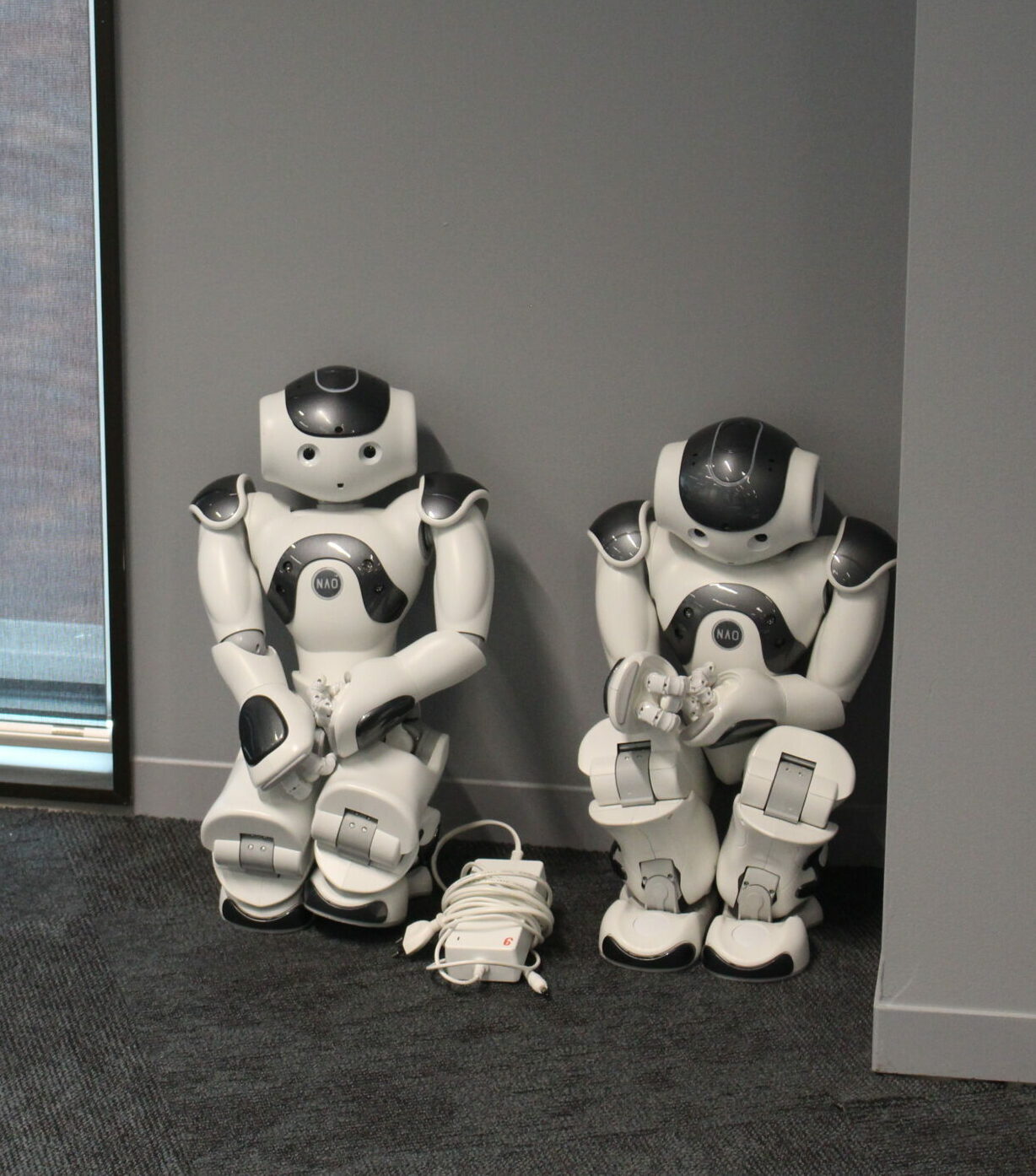 This paper takes recent approaches to the notion of “presence” in theatre studies to analyze how this concept is in action in the case of NAO Fit. This robot, designed by students of VU Amsterdam, is a fitness coach for young children, intended for placement in domestic environments. The robot’s presence as an embodied mind is expressed as it stands before a child to perform its tasks. It is not an illusion, nor merely a symbol or an allegory (Eckersall 2015, 126). This ‘performance’ calls for interaction and response from the child’s side, otherwise the robot has no reason to exist. Unexpected movements can be integrated to the design of the robot to enhance the presence of the robot.
This paper takes recent approaches to the notion of “presence” in theatre studies to analyze how this concept is in action in the case of NAO Fit. This robot, designed by students of VU Amsterdam, is a fitness coach for young children, intended for placement in domestic environments. The robot’s presence as an embodied mind is expressed as it stands before a child to perform its tasks. It is not an illusion, nor merely a symbol or an allegory (Eckersall 2015, 126). This ‘performance’ calls for interaction and response from the child’s side, otherwise the robot has no reason to exist. Unexpected movements can be integrated to the design of the robot to enhance the presence of the robot.
“Dramaturgical Aid for Designing Robots: Presence” – by Jeike Meijer
Concepts: presence, improvisation
Case Study: Sophia robot
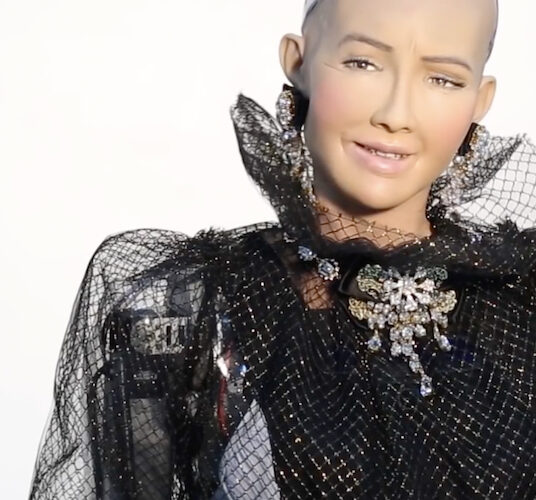 This paper examines Sophia the robot through the dramaturgical concept of presence to argue that personality and spontaneity are some of the most important elements in creating an “illusion of life” in robots. If the robot can become a good enough actor to have believable, human-like, responses, then the presence will feel more significant. To do so, the robot must have a background story and personality. By incorporating traits and stylized communication tactics, the presence of the robot becomes stronger and more convincing.
This paper examines Sophia the robot through the dramaturgical concept of presence to argue that personality and spontaneity are some of the most important elements in creating an “illusion of life” in robots. If the robot can become a good enough actor to have believable, human-like, responses, then the presence will feel more significant. To do so, the robot must have a background story and personality. By incorporating traits and stylized communication tactics, the presence of the robot becomes stronger and more convincing.
[/collapse]
[/collapsibles]
[collapsibles]
[collapse title = “Sound”]
“Sound” – by Herwin van Ee
Concepts: sound (noise, vocality)
Case Study: Nao robot
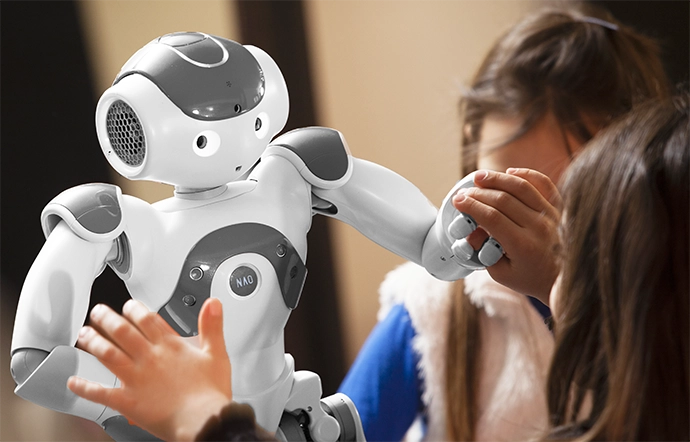 How could the conceptualization of ‘sound’ in theatre and performance studies be applied to improve robot design? This paper emphasizes the importance of sound in creating an identity for the Nao robot. By giving the Nao robot a custom-tailored sound identity, it can be very much possible to cross the uncanny valley as theorized in the case study. This can be done either by customizing the voice of the robot and/or the sounds it produces while moving around or carrying out tasks.
How could the conceptualization of ‘sound’ in theatre and performance studies be applied to improve robot design? This paper emphasizes the importance of sound in creating an identity for the Nao robot. By giving the Nao robot a custom-tailored sound identity, it can be very much possible to cross the uncanny valley as theorized in the case study. This can be done either by customizing the voice of the robot and/or the sounds it produces while moving around or carrying out tasks.
[/collapse]
[/collapsibles]

